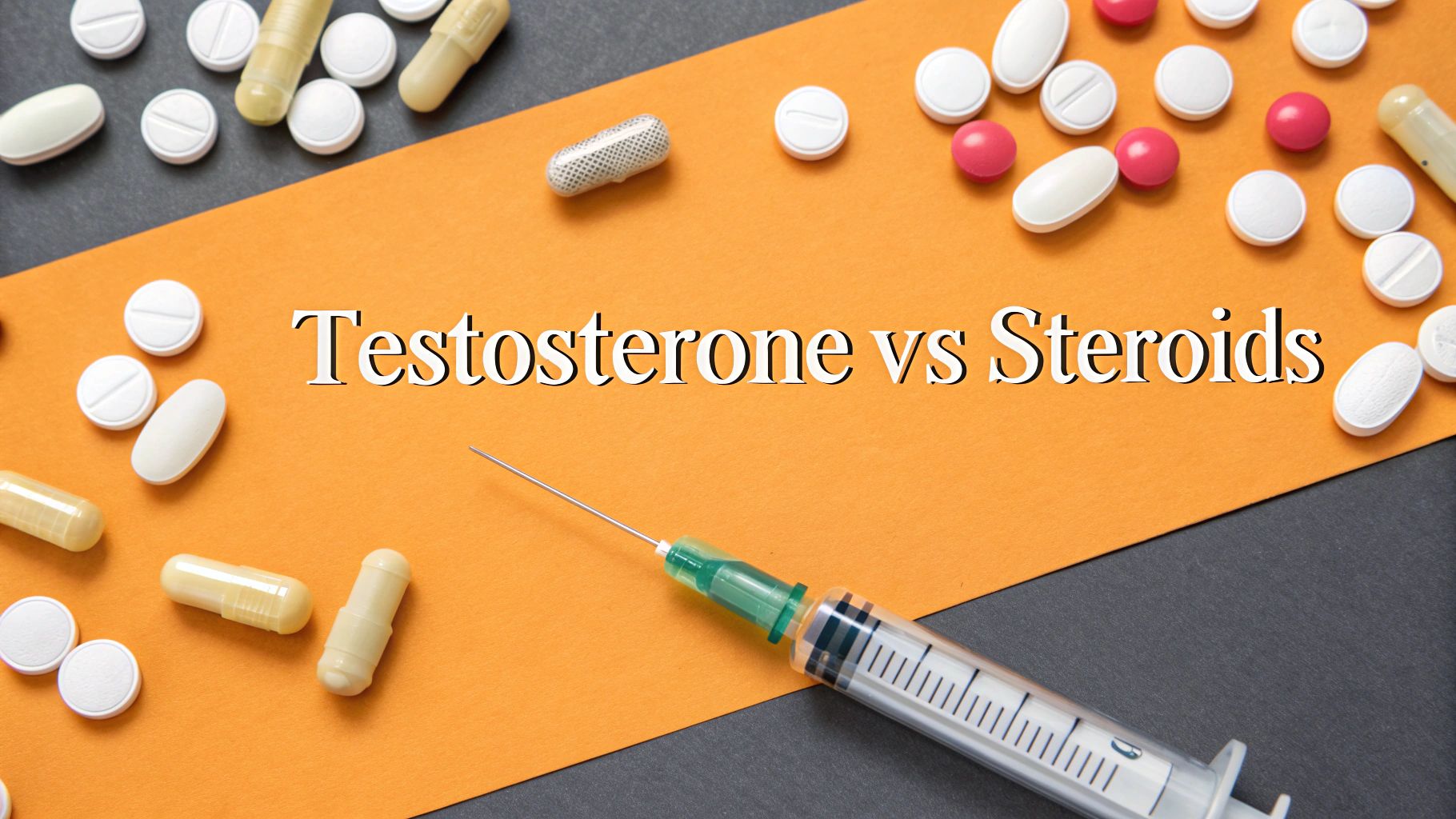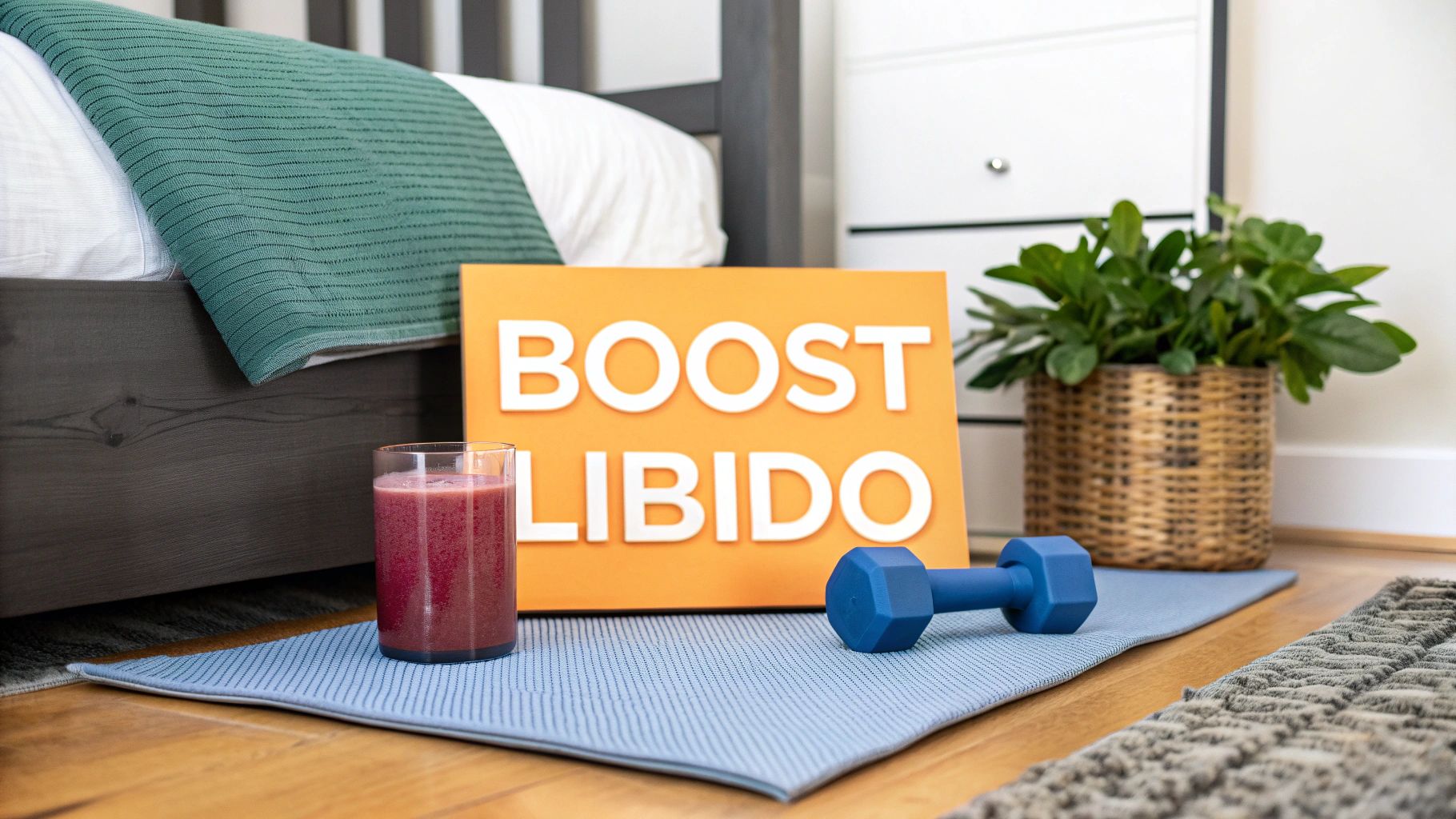Testosterone Oral vs Injection The Ultimate Comparison
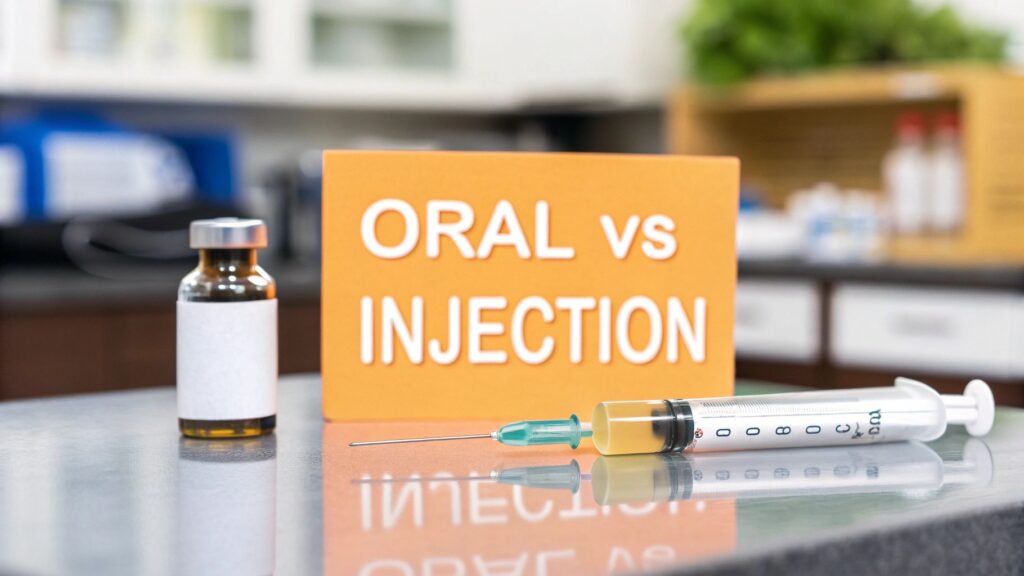
When it comes to testosterone replacement therapy (TRT), the debate between oral capsules and injections often boils down to a simple trade-off: less frequent dosing versus daily convenience. But the real story is a bit more nuanced than that.
While injectable testosterone offers a longer-lasting effect, meaning fewer administrations, modern oral capsules are designed to mimic the body's natural daily hormone patterns. The best choice isn't universal; it comes down to your lifestyle, medical profile, and what you’re most comfortable with.
Choosing Your TRT: Oral vs. Injection
Deciding on the right form of TRT is a major health decision. Both oral and injectable methods are proven to effectively raise your testosterone levels, but they get there in very different ways, creating distinct experiences for the patient. Your final choice will likely hinge on factors like how often you want to administer your therapy, how sensitive you are to hormonal fluctuations, and what fits best into your daily routine.
To make a truly informed decision, you have to understand the core differences in how they work. Injections are typically administered weekly or bi-weekly, an approach that many find convenient—a "set it and forget it" method. The downside, however, is that this can create significant peaks and valleys in your hormone levels. On the other hand, oral options are usually taken daily, offering unmatched ease of use and the potential for more stable, consistent hormone levels day in and day out.
The infographic below visualizes two of the most critical factors in this comparison: bioavailability (how much of the hormone your body can actually use) and the dosing frequency required for each method.
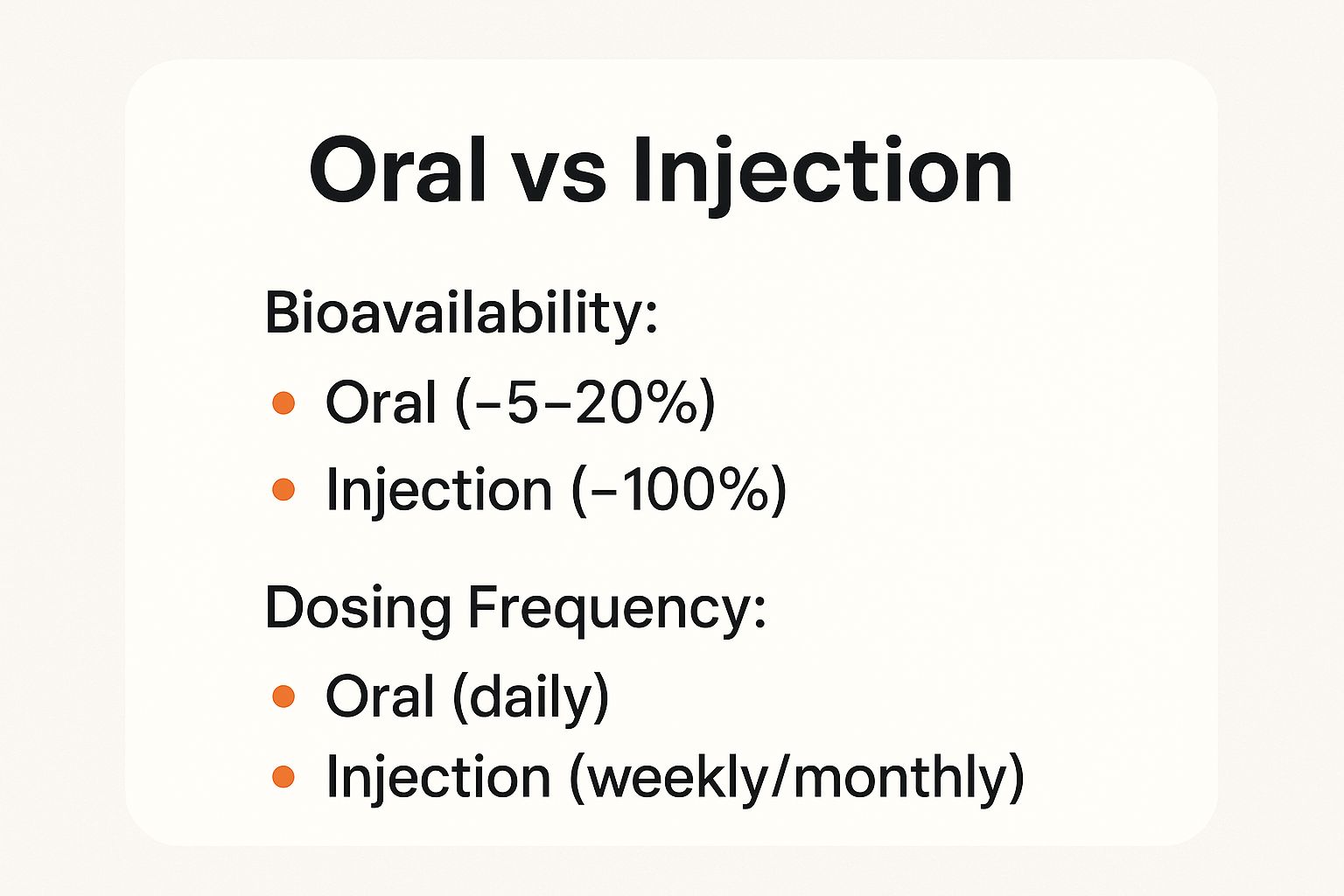
As you can see, injections are nearly 100% bioavailable, which is why they are so effective. Oral absorption is naturally lower, but the dosages are carefully calibrated to deliver the same therapeutic results.
Key Takeaway: The oral vs. injection debate is about more than just pills versus needles. It's a question of how each method interacts with your body's hormonal balance and your lifestyle. For men sensitive to hormonal swings, the stable daily levels from oral TRT may be ideal. For others, the convenience of infrequent injections is the bigger draw.
To help you get a clearer picture right away, let's start with a high-level comparison.
Quick Look: Oral vs. Injectable Testosterone
The table below breaks down the fundamental differences between oral and injectable testosterone at a glance, giving you a quick summary of what to expect from each option.
| Attribute | Oral Testosterone | Injectable Testosterone |
|---|---|---|
| Dosing Frequency | Daily (once or twice per day) | Weekly, bi-weekly, or monthly |
| Hormone Stability | More stable, mimics natural daily rhythm | Creates "peaks and troughs" |
| Convenience | High (simple pill, easy to travel with) | Moderate (requires supplies, self-injection) |
| Potential Side Effects | Fewer issues with hormone spikes | Higher risk of erythrocytosis, mood swings |
This quick comparison highlights the main trade-offs you'll be considering. Now, let's dive deeper into what these differences mean for you in the real world.
How Each Testosterone Method Works in Your Body
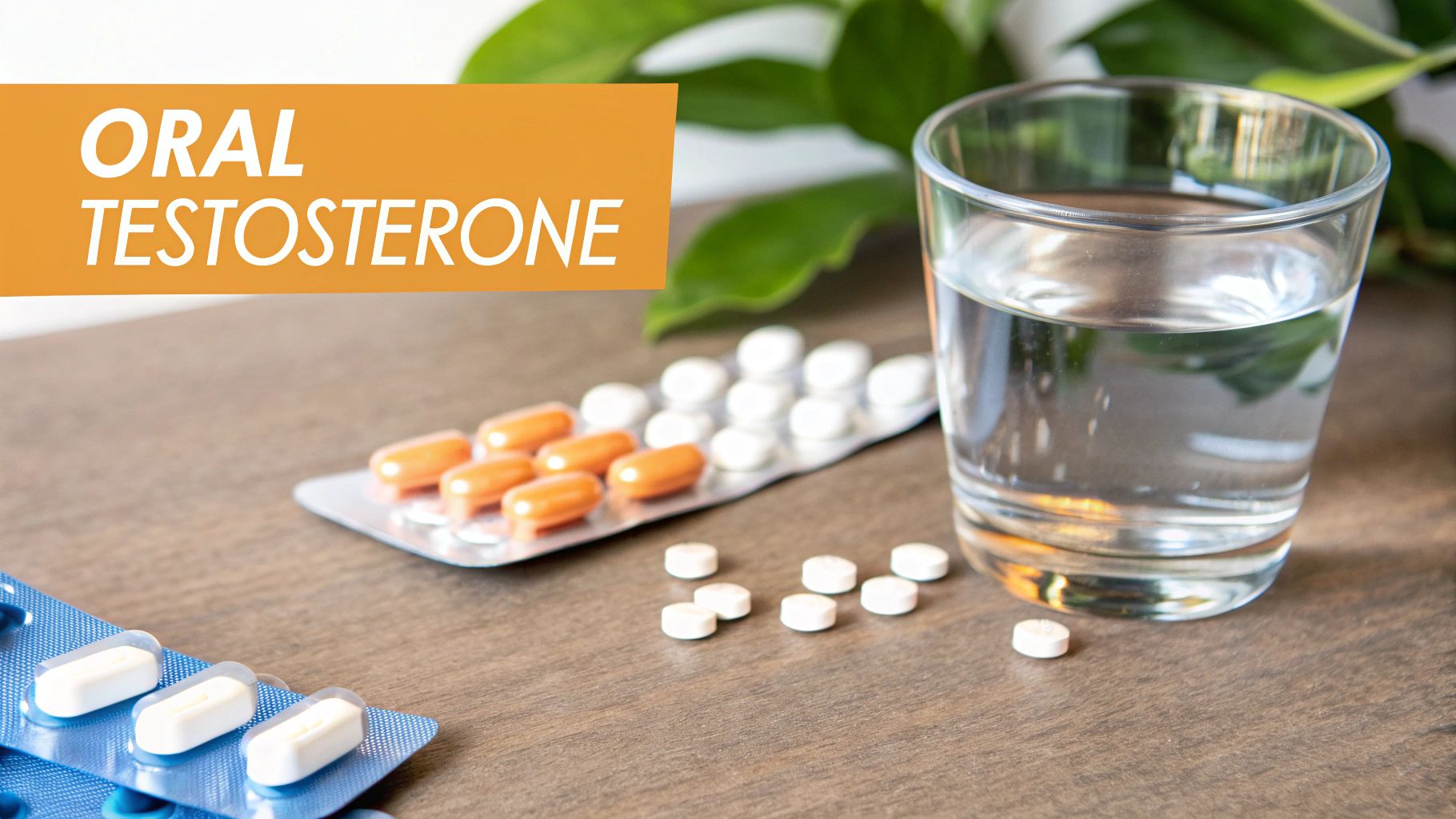
To make a confident call in the testosterone oral vs injection debate, you have to get a feel for how each one actually behaves inside your body. These aren't just two ways to take the same medicine; they’re entirely different processes. The path you choose creates distinct hormonal patterns that will shape everything from your energy levels to the side effects you might encounter.
Modern oral testosterone, specifically testosterone undecanoate, was engineered to sidestep the liver safety issues that plagued older pills. It’s not your grandpa’s TRT. This new generation uses a clever absorption pathway to keep your liver out of the equation.
When you take a capsule with a meal containing some fat, the testosterone is absorbed through your small intestine and directly into your lymphatic system. This slick move allows the hormone to completely bypass the "first-pass metabolism" in the liver, where it would otherwise get broken down and potentially cause stress. From the lymphatic system, it’s released into your bloodstream, ready to go to work.
The Daily Rhythm of Oral Testosterone
This lymphatic absorption route results in a pharmacokinetic profile that does a surprisingly good job of mimicking the body's natural daily hormone cycle. Your testosterone levels rise after you take your dose, peak during the day, and then gently fall overnight. It's a lot like the natural circadian rhythm seen in a healthy young man.
This daily pattern offers a couple of potential real-world advantages:
- More Stable Energy: By sidestepping the sharp, unnatural spikes of other methods, daily dosing can lead to a more consistent, predictable feeling of energy and mood throughout the day.
- Reduced Fluctuation: You are far less likely to experience the “roller coaster” of symptoms that can happen with less frequent dosing methods.
By working with your body's natural clock, oral TRT aims for a smoother, more predictable hormonal baseline. For more on this, you can check out our guide covering the science-based secrets to boosting testosterone levels.
The Depot Effect of Injectable Testosterone
Injectable testosterone, like testosterone cypionate or enanthate, operates on a totally different principle: the depot effect. When you inject the oil-based solution into a large muscle—think your glute or thigh—it forms a small reservoir, or "depot," right there in the muscle tissue.
From this depot, the testosterone is slowly and steadily released into your bloodstream over a period of days or even weeks. This is the whole reason injections are needed so much less often, typically just once a week or every two weeks.
Injectable testosterone creates a distinct "peak and trough" cycle. Your hormone levels spike significantly in the first few days after the shot and then steadily decline until it’s time for the next dose. While it's great at raising your overall testosterone levels, this pattern doesn't replicate the body’s natural daily hormonal rhythm.
This depot mechanism is incredibly effective, ensuring almost 100% bioavailability of the hormone. But it’s this less frequent, more intense delivery that is the primary source of the hormonal peaks and valleys that some men find challenging to manage.
Comparing Efficacy and Hormone Stability
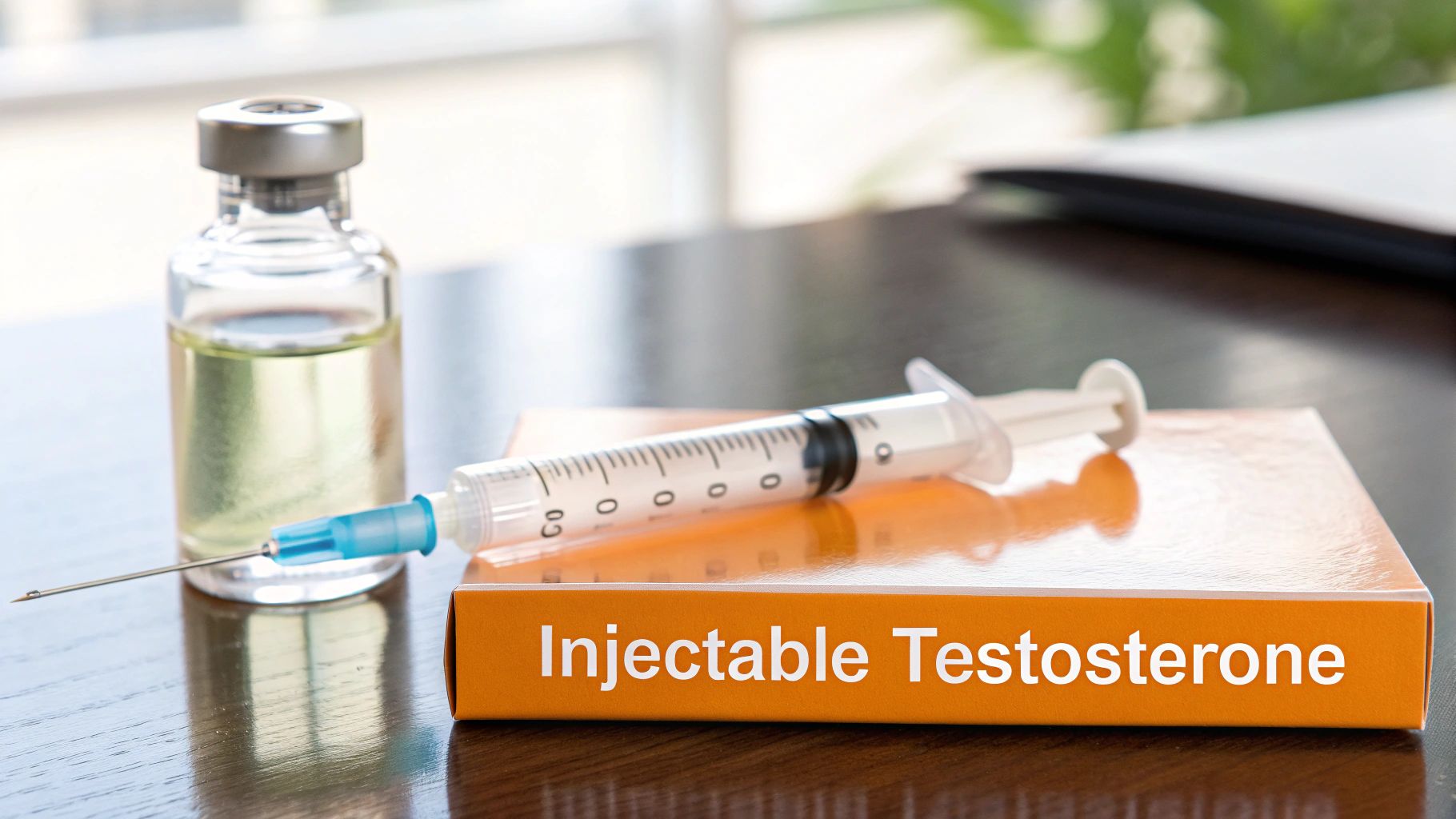
When you’re weighing testosterone oral vs injection options, the first question is always the simplest: does it actually work? The short answer is yes—both methods are excellent at getting your serum testosterone into the healthy, therapeutic range. The real difference isn’t if they work, but how they deliver the hormone and maintain your levels day to day.
This delivery mechanism creates two completely different hormonal experiences. Oral testosterone, taken daily, is engineered to work with your body’s natural rhythm. Injections, on the other hand, use a less frequent schedule that creates a prolonged but less natural hormonal cycle. Getting a handle on this distinction is the key to figuring out which therapy is the right fit for your body and your life.
The Peak and Trough Effect of Injections
Injectable testosterone is famous for what’s known as the "peak and trough" effect. In the first couple of days after an injection, your testosterone levels can shoot up to high-normal or even supraphysiological levels. That’s the "peak." It’s often when men feel fantastic.
But what goes up must come down. Over the next week or two, your levels will start a slow, steady decline until your next scheduled dose. This is the "trough." For many men, this up-and-down cycle leads to noticeable swings in mood, energy, and libido—feeling great right after the shot, but then watching those old symptoms creep back in as the next one approaches.
The Circadian Advantage of Oral Testosterone
This is where modern oral testosterone presents a really compelling alternative to that hormonal roller coaster. Because it's absorbed and processed daily, it does a much better job of mimicking the body's natural circadian rhythm—higher testosterone in the morning that gradually tapers off by evening.
The goal of modern oral TRT is not just to elevate testosterone but to restore a more natural daily hormonal pattern. This stability can lead to more consistent energy, mood, and cognitive function without the dramatic peaks and troughs associated with injections.
This approach is all about stability, and the data shows it’s incredibly effective. Following protocols where the daily dose is taken with a bit of fat to maximize absorption, total testosterone levels have been shown to rise by an average of 865.5 ng/dL (a 307.6% increase). Free testosterone saw an even bigger jump, climbing by 295 pg/mL (a 470.1% rise).
These are impressive numbers, easily on par with what you'd see from injections. The crucial difference is that these gains are achieved with a much smoother, more stable daily hormonal profile. You can discover more insights about oral testosterone efficacy and its unique benefits over at Maximus Tribe.
Ultimately, while both methods will successfully get your testosterone where it needs to be, their impact on your day-to-day life is quite different. Injections give you long-lasting effects with infrequent dosing, but often at the cost of hormonal stability. Oral therapy asks for a daily commitment but rewards you with a steadier, more natural-feeling hormonal balance that many men prefer for their long-term well-being.
A Deep Dive Into Safety And Side Effects
When we talk about oral versus injectable testosterone, the conversation around safety has changed a lot over the years. Outdated fears about oral testosterone wrecking your liver are mostly a thing of the past, thanks to modern formulations like testosterone undecanoate, which are specifically designed to bypass the liver. This shifts the focus to a more nuanced discussion about risk, one that centers on how each delivery method makes your hormone levels behave day-to-day.
The main safety difference between these two comes down to their pharmacokinetic profiles. Think of it as the stable, daily rhythm of oral therapy versus the sharp “peak and trough” cycle of injections. It’s not just about the testosterone itself, but how your body experiences its delivery.
Cardiovascular Risks And Hormone Spikes
Injectable testosterone is known for causing a rapid, high spike in hormone levels right after the shot, followed by a steady decline until the next one. This "rollercoaster" effect, while effective at raising your average testosterone levels, has been linked to a higher risk of certain side effects when compared to therapies that offer more stable, daily delivery.
For example, a landmark 2015 study dug into the safety of different testosterone forms across large groups of patients. It revealed that men using injectable testosterone had a noticeably higher risk of cardiovascular and cerebrovascular events compared to those using testosterone gels, which provide steady daily levels much like oral capsules do.
The study found that for every 1,000 men treated for a year, there were 36.6 events (like heart attacks or strokes) among injection users, versus 23.1 events for gel users. You can explore the full study on comparative testosterone safety to get a better handle on these findings.
This data suggests that the intense, supraphysiological spikes in testosterone after an injection may moderately increase cardiovascular strain—a risk that is less pronounced with more stable, daily-dosing methods.
Comparing Key Side Effect Profiles
The way testosterone gets into your system influences more than just your heart health. Those hormonal swings from injections are also more likely to cause other side effects that guys notice in their daily lives. A major concern here is polycythemia, which is an overproduction of red blood cells.
This condition makes your blood thicker and more viscous, raising the risk of blood clots and cardiovascular events. Research has consistently shown that injectable testosterone is associated with a significantly higher incidence of polycythemia compared to oral or transdermal options. This is widely believed to be a direct result of the high testosterone peaks stimulating bone marrow more intensely than steady-state levels would.
To give you a clearer picture, here’s a practical look at how the risk profiles for oral and injectable testosterone stack up against each other.
Risk Profile Comparison for Oral vs Injection
This table provides a comparative overview of the potential side effect risks associated with the different pharmacokinetic profiles of oral and injectable testosterone.
| Side Effect Type | Oral Testosterone (Daily Dosing) | Injectable Testosterone (Weekly/Bi-Weekly) |
|---|---|---|
| Polycythemia Risk | Lower risk due to stable, physiological levels. | Higher risk due to intense hormone spikes. |
| Mood Fluctuations | Less common, as daily dosing avoids troughs. | More common, tied to the "peak and trough" cycle. |
| Liver Stress | Minimal with modern formulations. | No direct liver impact. |
| Injection Site Issues | Not applicable. | Can cause pain, soreness, or infection. |
As you can see, the hormonal delivery pattern has a direct impact on the types of side effects you're more likely to encounter. While oral options avoid injection-related issues and may provide a more stable experience, injections bypass any first-pass metabolism entirely.
Because of all these potential issues, consistent lab work is completely non-negotiable for anyone on TRT. Proper and regular blood tests are vital for catching and managing side effects before they escalate into serious problems. You can learn more by reading our guide on why TRT monitoring is so important. Ultimately, the "safer" option really depends on your individual health profile and how your body responds to different hormonal patterns.
Lifestyle Fit and Patient Adherence
Beyond the clinical data and side effect profiles, the most important question for many men boils down to this: “Which therapy will I actually stick with?” The best testosterone replacement therapy is the one that fits seamlessly into your life, because inconsistent use means inconsistent results. This is where the practical differences between oral and injectable testosterone really come into focus.
The debate often centers on a simple trade-off: daily convenience versus infrequent administration. A daily oral capsule is straightforward. It requires no special equipment and can be taken discreetly anywhere you are. For men who travel frequently, this is a massive advantage over packing needles, vials, alcohol swabs, and a sharps container.
However, that daily requirement demands a solid routine. Forgetting a dose can disrupt the steady hormone levels that oral therapy is designed to create, sending your progress backward.
The Realities of Self-Injection
Injectable testosterone, on the other hand, offers a much less frequent dosing schedule—usually once or twice a week. This "set it and forget it" approach appeals to men who are comfortable with the process of self-injection and prefer not to think about their therapy every single day.
But that process can be a major hurdle. Needle anxiety is a real and significant barrier for many people. The ritual of preparing the injection, the potential for soreness at the injection site, and the mental block of the act itself can lead to procrastination or missed doses, which directly undermines the treatment's effectiveness.
Key Insight: Adherence isn't just about remembering your medicine. It's about overcoming the practical and psychological roadblocks. For some, the sheer simplicity of taking a pill outweighs the appeal of infrequent injections, especially if the process of self-injecting is a source of stress.
How Adherence Impacts Outcomes
Poor adherence doesn't just mean your symptoms fluctuate; it often leads to patients giving up on therapy altogether. Interestingly, research shows that adherence can vary dramatically even within the injectable category, which highlights just how much dosing frequency impacts long-term commitment.
A 2022 retrospective study on injectable testosterone found that adherence rates were far higher for men on long-acting formulations (testosterone undecanoate, or TU) compared to those on short-acting ones (testosterone cypionate, or TC). In the latter half of the first year, 82.0% of men using long-acting injections were adherent, versus only 40.8% on the more frequent short-acting version.
Ultimately, 41.9% of the long-acting group continued therapy for a full year, compared to a meager 8.2% of the short-acting group. You can read the full research on patient adherence in testosterone therapy for a deeper look at these powerful findings.
This data sends a clear message: the less often you have to administer a treatment, the more likely you are to stick with it. This principle underscores the lifestyle advantage of both long-acting injections and simple daily oral options. Choosing between them comes down to your personal comfort level, daily habits, and what you can realistically sustain for the long haul.
Which Testosterone Therapy Is Right for You?
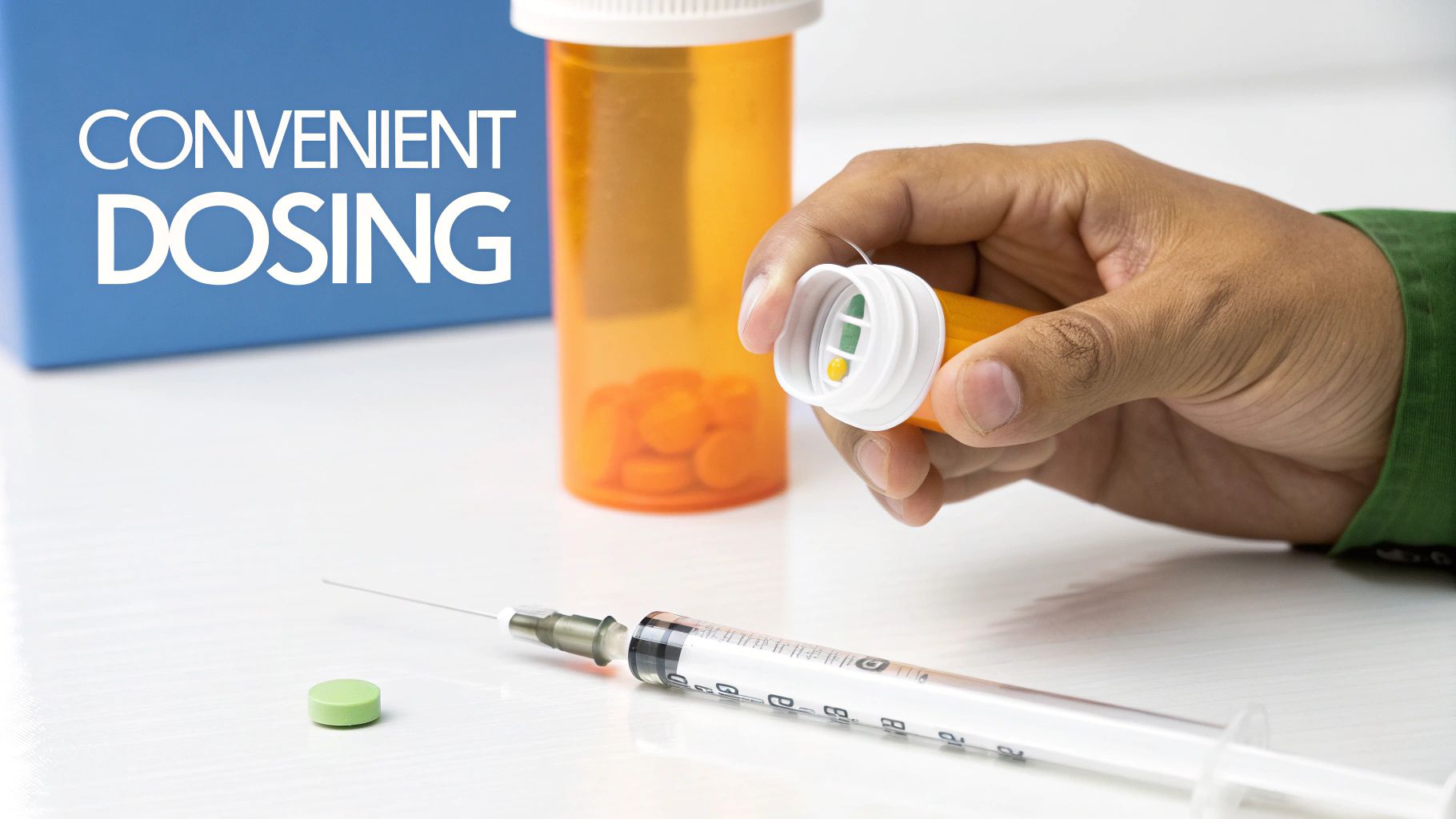
Choosing between oral and injectable testosterone isn't about finding a one-size-fits-all answer. It's about finding the right fit for your life. This decision brings together everything we've talked about—from how the hormone works in your body to how the therapy fits into your daily routine. The real goal is to match a treatment to your health, lifestyle, and what you’re comfortable with.
The testosterone oral vs injection debate really boils down to a few honest questions you need to ask yourself. Are you okay with self-injections? Do you travel a lot? How do you feel when your hormone levels fluctuate? Your answers will guide you toward a therapy that's not just effective, but sustainable for the long haul.
Situational Recommendations
To make things clearer, let's walk through a few practical scenarios. These examples show how different lifestyles and priorities can point toward one method over the other, giving you a solid framework for your conversation with your doctor.
Oral Testosterone May Be Your Best Fit If:
- You have a fear of needles. Needle anxiety is a real and common concern. The straightforward simplicity of taking a daily pill completely removes this major hurdle to staying consistent with your treatment.
- You travel often. Capsules are discreet and incredibly easy to pack. You won't have to worry about carrying around needles, vials, or a sharps container, making travel a breeze.
- You are sensitive to hormonal swings. If you've felt your mood or energy bounce around on other therapies, the steady, daily rhythm of oral TRT can offer a much smoother and more predictable experience.
Injectable Testosterone Could Be the Ideal Choice If:
- You prioritize a less frequent schedule. The "set it and forget it" appeal of a weekly or bi-weekly shot is a huge plus for men who don’t want to think about their therapy every single day.
- Cost is a primary concern. Generally speaking, injectable testosterone is one of the most cost-effective forms of TRT available, making it a practical choice for many.
- You are comfortable with self-injection. If the process of giving yourself a shot doesn't bother you, injections are a powerful and time-tested method for raising testosterone levels reliably.
Ultimately, the best therapy is the one you will actually stick with. Whether that’s a simple daily pill or an infrequent injection, your commitment is the foundation for reaching your long-term health goals.
This guidance is here to help you have a productive, informed talk with your doctor. By understanding these nuances, you can better explore the benefits of hormone replacement therapy and improve your well-being with a plan that is truly built for you.
Your Questions, Answered
Deciding on the right TRT path brings up a lot of questions. It's completely normal. Here are some straightforward answers to the most common queries we hear when comparing oral and injectable testosterone, so you can feel confident in your choice.
Can You Switch Between Oral and Injectable TRT?
Yes, absolutely. Switching between different forms of testosterone therapy is quite common. A patient might move from injections to oral capsules to sidestep needle anxiety, make travel easier, or even out their hormone levels for a more stable feeling. On the other hand, someone could switch from oral to injections to lower costs or because they prefer a less frequent dosing schedule.
Just know it's not a simple swap. Because each method delivers testosterone to your body differently, your doctor can't just do a one-for-one exchange. They'll need to calculate a new starting dose and schedule follow-up blood tests to make sure your levels land squarely in that optimal therapeutic range.
Switching TRT methods isn't a DIY project—it requires careful medical supervision. Your dosage has to be completely recalibrated and monitored to keep you safe and ensure the therapy is still working for you.
Which Option Is More Cost-Effective?
When it comes to your budget, injectable testosterone is almost always the more cost-effective option. The raw price of the hormone in vials is significantly lower than modern, branded oral testosterone capsules. Of course, you do have to factor in the extra costs for supplies like needles, syringes, and alcohol swabs.
While oral testosterone might have a higher price tag per dose, many guys find its convenience and super-stable delivery well worth the investment. Before you decide, always check with your insurance provider. Coverage can dramatically change your out-of-pocket costs for either option.
Ready to find a TRT plan that actually fits your life? Elite Bioscience provides personalized testosterone therapies delivered securely and discreetly to your door. Take back control of your health journey and get started with Elite Bioscience today.
QUICK SEARCH
Make an account today to start your journey towards a better and healthier lifestyle.




